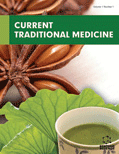
Abstract
Dementia is a brain disorder with progressive neurological disease. It destroys essential brain cells, impairing memory, thinking, and behavior in a severe way to impact health, enduring interests, and social life. Memory, cognition, orientation, learning capacity, language, and judgments gradually get impaired. Dementia results from anatomical and functional abnormalities, cerebral ischemia, energy deficits, calcium excess, glutamate-mediated excitotoxicity, and oxidative stress. Vascular dementia (VaD), which accounts for 10-15% of dementia cases, is the second most frequent form of dementia after Alzheimer's disease (AD). There are currently no approved pharmaceutical treatments for VaD, and traditional anti-AD therapies only offer modest, temporary relief from the symptoms of VaD. Since herbal remedies have a multicomponent and multitarget approach, they may provide effective treatments for VaD. Herbal remedies have been used for centuries to address dementia-like symptoms. This author describes some preliminary research that supports using herbal drugs in managing vascular dementia and dementia.
Keywords: Dementia, curcuma longa, vascular dementia, memory, cognition, Alzheimer’s diseases.
[http://dx.doi.org/10.1155/2016/7293626]
[http://dx.doi.org/10.3389/fnagi.2018.00003] [PMID: 29483867]
[http://dx.doi.org/10.3389/fphar.2021.825330] [PMID: 35242028]
[http://dx.doi.org/10.1155/2018/2481076]
[http://dx.doi.org/10.1007/s13311-011-0047-z] [PMID: 21556678]
[http://dx.doi.org/10.1016/j.bgm.2014.11.001]
[http://dx.doi.org/10.4236/aad.2016.53007]
[http://dx.doi.org/10.1111/bpa.12935] [PMID: 33410232]
[PMID: 28179815]
[http://dx.doi.org/10.1016/j.jep.2017.12.015] [PMID: 29248451]
[http://dx.doi.org/10.1021/acschemneuro.7b00283] [PMID: 28862431]
[http://dx.doi.org/10.1016/j.bbrc.2020.01.123] [PMID: 32037088]
[http://dx.doi.org/10.1016/j.neuroscience.2019.05.037] [PMID: 31146009]
[http://dx.doi.org/10.2147/NDT.S214976] [PMID: 31814724]
[http://dx.doi.org/10.3389/fphar.2021.689625] [PMID: 34194332]
[http://dx.doi.org/10.1002/iub.1704] [PMID: 29247598]
[http://dx.doi.org/10.3892/etm.2014.1542] [PMID: 24660032]
[http://dx.doi.org/10.1590/1414-431x20198371] [PMID: 31721903]
[http://dx.doi.org/10.1007/s40261-022-01136-8] [PMID: 35349093]
[http://dx.doi.org/10.1186/s40780-015-0014-7] [PMID: 26819725]
[http://dx.doi.org/10.3389/fnagi.2016.00276] [PMID: 27999539]
[http://dx.doi.org/10.1007/s11101-014-9384-y]
[http://dx.doi.org/10.1080/09168451.2015.1052773] [PMID: 26059088]
[http://dx.doi.org/10.1186/1472-6882-14-88] [PMID: 24597901]
[http://dx.doi.org/10.1080/13543776.2019.1556258] [PMID: 30513224]
[http://dx.doi.org/10.1155/2021/2412220] [PMID: 34899899]
[http://dx.doi.org/10.1002/agm2.12230] [PMID: 36606270]
[http://dx.doi.org/10.21203/rs.3.rs-2069630/v1]
[http://dx.doi.org/10.1016/j.jep.2015.01.041] [PMID: 25660331]
[http://dx.doi.org/10.1080/23802359.2020.1778574] [PMID: 33457827]
[http://dx.doi.org/10.1186/s12906-015-0943-6] [PMID: 26597908]
[http://dx.doi.org/10.3390/antiox9090857] [PMID: 32933217]
[http://dx.doi.org/10.1016/j.jpha.2012.12.001] [PMID: 29403824]
[http://dx.doi.org/10.1016/j.jep.2016.07.073] [PMID: 27473605]
[http://dx.doi.org/10.1016/j.jtcme.2017.11.002] [PMID: 30302329]
[http://dx.doi.org/10.1016/j.jtcme.2017.08.002] [PMID: 31453123]
[http://dx.doi.org/10.1371/journal.pone.0037080] [PMID: 22606332]
[http://dx.doi.org/10.4172/2161-0460.1000245]
[http://dx.doi.org/10.4103/ijpvm.IJPVM_75_18] [PMID: 30450168]
[http://dx.doi.org/10.1080/13880209.2017.1285945] [PMID: 28164735]
[http://dx.doi.org/10.1016/j.jtcme.2017.01.002] [PMID: 29034205]
[http://dx.doi.org/10.4103/0253-7613.129312] [PMID: 24741189]
[http://dx.doi.org/10.1080/0972060X.2013.854487]
[http://dx.doi.org/10.1007/s00044-009-9274-9]
[http://dx.doi.org/10.1007/s10571-010-9502-3] [PMID: 20563702]
[http://dx.doi.org/10.37360/blacpma.21.20.4.30]
[http://dx.doi.org/10.1186/2008-2231-20-42] [PMID: 23351182]
[http://dx.doi.org/10.9734/jpri/2021/v33i59A34268]
[http://dx.doi.org/10.1016/j.jddst.2019.03.006]
[http://dx.doi.org/10.1016/j.phymed.2008.12.018] [PMID: 19211237]
[http://dx.doi.org/10.1186/1475-2875-10-S1-S4] [PMID: 21411015]
[http://dx.doi.org/10.1590/S0102-695X2013005000018]
[http://dx.doi.org/10.1078/0944-7113-00060] [PMID: 11695885]
[http://dx.doi.org/10.1186/alzrt54] [PMID: 21067555]
[http://dx.doi.org/10.4103/1673-5374.205108] [PMID: 28553349]





























